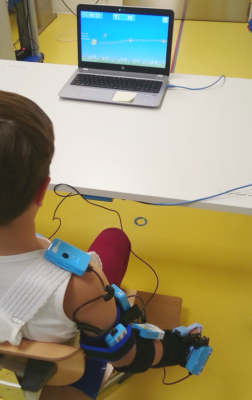A computer game using movement sensors can help assess the success of rehabilitation therapy in children with brain injury. This may have implications for the future evaluation of therapies.
How specific are novel rehabilitation interventions, especially those using robots? Can they restore normal function in patients with brain injuries or is their effect due to compensatory movements? To answer these questions, the ability to assess selective, single-joint movements will prove helpful. Currently a therapist rates the selectivity of movements on a crude scale of ‘no’, ‘impaired’, and ‘normal’ movement control. We looked for a more sensitive way to quantify selective joint movement in children with brain injuries.

A video game to assess selective movement control
For that reason, our group from the Swiss Children’s Rehab in Affoltern am Albis created a game-like assessment in collaboration with Reha-Stim Medtech AG in Schlieren. Healthy adults, children and patients with brain injuries played the game, which uses movement sensors multiple inertial measurement units (IMUs) to track arm or leg movements. The player of the game must follow a target path with an avatar by specifically moving one single joint. The resulting score is an indication of how well patients followed the target path and how frequent and intense involuntary movements were.
In this first evaluation, we found that the game score for involuntary movements correlated well with the involuntary movements observed by the therapists when patients played the game. This indicates the validity of using IMUs to track selective movement control and our algorithm to analyze the data.
Implications of these findings
By using low-cost IMUs, we hope it will become easier to determine more objectively, accurately, and sensitively whether a movement is selective, and assess where involuntary movements occur. This in turn will enable therapists and researchers to better evaluate the success of rehabilitation therapy and the underlying mechanism of improvements. We now aim to test whether such a therapeutic intervention, designed to specifically promote selective movements, can indeed restore normal function rather than encourage compensatory movements.
By Jeffrey Keller, Swiss Children’s Rehab, Affoltern am Albis, Switzerland, Pediatric Rehab Research Group
Keller JW, Balzer J, Fahr A, Lieber J, Keller U, van Hedel HJA. First validation of a novel assessgame quantifying selective voluntary motor control in children with upper motor neuron lesions. Sci Rep. 2019;9(1):19972. Published 2019 Dec 30. Pdf
Header image: Screenshot of assessment game. Body copy image: Child playing the assessment game with multisensors.